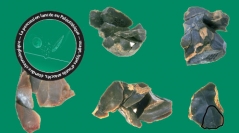

 Comptes Rendus Palevol
21 (24) - Pages 489-509
Comptes Rendus Palevol
21 (24) - Pages 489-509The quartz component of the Champs de Bossuet (CdB) industry has been the subject of technological and techno-functional analyses focused on the ergonomic characterization of percussive tools related to their morphologies, their dimensions and masses but especially on their Active Percussion Zone (APZ) (morphology, extent, location). After assessing the position held by the percussive tools in the quartz component, they will be described on the basis of a subdivision into two large families correlated to their function and mode of operation: sharp percussion tools and blunt percussion tools (Viallet et al. 2022). Among this last group, constituting the panoply of percutors (of sensu lato size), ergonomic specificities could be highlighted in a correlation with a specialization of the lithic flint production mode for which they were used: discoid debitage with pseudo-Levallois point and its ramifications (Bourguignon et al. 2000; Lenoble et al. 2000 ; Bourguignon & Turq 2003). Each of the characteristics (weights, size and morphology) and their grouping by categories will be described and quantified and their function evaluated. Finally, we will propose, for classes of hammerstones with very specific size and ergonomic characteristics, a terminology derived from the current technical vocabulary describing the «striking tools» and in particular hammers for purposes of differentiation in the rich panoply of percussive tools and comparisons in other archaeological records.
Hammerstones, Discoid, Pseudo-Levallois point